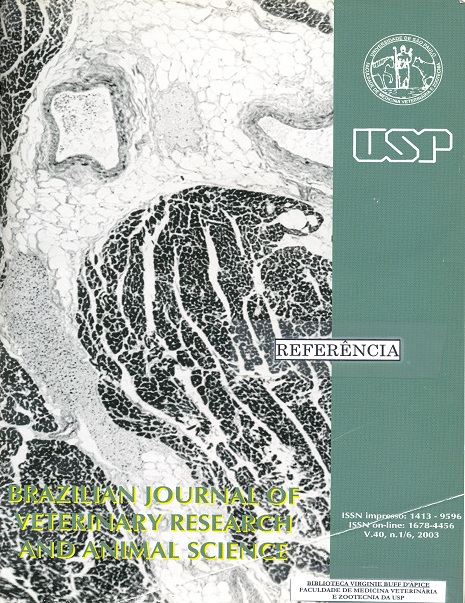Origin of brachial plexus of rock cavies (Kerodon rupestris wied, 1820)
DOI:
https://doi.org/10.1590/S1413-95962003000600001Keywords:
Brachial plexus, Anatomy, Rock caviesAbstract
Rock cavy, Kerodon rupestris a rodent mammal of the Caviidae family, very similar to the cavy is highly adapted to the conditions of heat, shortage of water and food, mainly during the great droughts periods that periodically devastate the northeastern semi-arid area of Brazil. In the literature a shortage of data is verified regarding the functional anatomy of the rock cavies especially of works that involve the anatomy of the brachial plexus. Aiming at to elucidate the behavior of the brachial plexus of rock cavies and with the purpose of contributing for the development of the compared anatomy, this research was accomplished. Ten animals of different ages were used (nine males and one female) coming from the Wild Animals Multiplication Center (CEMAS) of the Superior School of Agriculture of Mossoró-ESAM. After the slaughter, bilateral dissection of the brachia plexuses took place, and the results were registered in schematic drawings, and the dispositions grouped in tables for subsequent statistical analysis grounded in the percentile frequency. It was observed that the brachium plexus of rock cavy is the result from established communications, mainly, among the ventral ramus of the last three cervical nerves and of the first two thoracic nerves, having a contribution of the fifth cervical nerve in 35.00% of the cases. In 40.00% of the dissections the most frequent plexus was of the type C6, C7, C8, T1 and T2.Downloads
Download data is not yet available.
Downloads
Published
2003-01-01
Issue
Section
UNDEFINIED
License
The journal content is authorized under the Creative Commons BY-NC-SA license (summary of the license: https://
How to Cite
1.
Santana JJ, Albuquerque JFG de, Moura CEB de, Costa WP, Oliveira MF de, Barreto Júnior RA, et al. Origin of brachial plexus of rock cavies (Kerodon rupestris wied, 1820). Braz. J. Vet. Res. Anim. Sci. [Internet]. 2003 Jan. 1 [cited 2025 Feb. 16];40(6):391-6. Available from: https://revistas.usp.br/bjvras/article/view/11284





